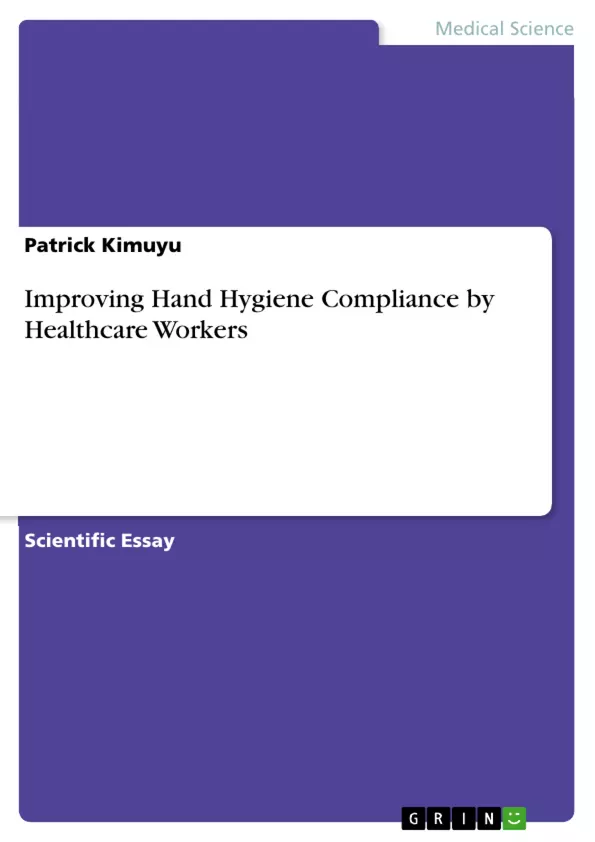Hand hygiene has emerged as the only single strategy that has the potential for reducing hospital-acquired infections. Evidence indicates that hospital-acquired infections pose an immense hazard for patients within the hospital environment, and healthcare workers, including nurses are involved in the transmission of these infections. This explains why health organizations such as WHO, The Joint Commission and Centers for Disease Control have embarked on spearheading education and awareness on hand hygiene.
Despite these efforts, evidence indicates that healthcare workers continue to exhibit low levels of hand hygiene compliance. Therefore, this essay will demonstrate how nurses can assume a leadership role within the hospital settings in accordance with the health safety standards (National Safety and Quality Health Services) as outlined by the Australian Commission on Safety and Quality in Health Care [ACSQHC]. It will be discussed how nurses can adopt hand hygiene strategies to improve compliance to the national hand hygiene initiative in the wards as one of the key approaches for preventing and controlling hospital-acquired infections.
Inhaltsverzeichnis (Table of Contents)
- Improving Hand Hygiene Compliance by Healthcare Workers
- Introduction
- Hand Hygiene: A Vital Tool for Preventing Hospital-Acquired Infections
- Nurses' Leadership Role in Advancing Hand Hygiene
- Multi-modal Educational Strategies
- The Importance of Education and Training
- Evidence-Based Practices and Hand Hygiene Guidelines
- Behavioral Changes Strategies
- The Role of Hand Hygiene Products
- The Effectiveness of Alcohol-Based Hand Rubs
Zielsetzung und Themenschwerpunkte (Objectives and Key Themes)
This essay aims to demonstrate how nurses can play a leadership role in improving hand hygiene compliance within hospital settings, aligning with Australian health safety standards. It discusses how nurses can adopt hand hygiene strategies to enhance compliance with the national hand hygiene initiative and effectively prevent and control hospital-acquired infections.
- Importance of Hand Hygiene in Healthcare
- Nurses' Role in Hand Hygiene Compliance
- Multi-modal Educational Strategies for Hand Hygiene
- Behavioral Changes Strategies for Hand Hygiene
- Evidence-Based Practices for Hand Hygiene Improvement
Zusammenfassung der Kapitel (Chapter Summaries)
- Introduction: This chapter emphasizes the significance of hand hygiene in preventing hospital-acquired infections and highlights the prevalence and impact of these infections globally.
- Hand Hygiene: A Vital Tool for Preventing Hospital-Acquired Infections: This section explores the role of healthcare workers, particularly nurses, in the transmission of hospital-acquired infections and discusses the importance of hand hygiene in mitigating this risk.
- Nurses' Leadership Role in Advancing Hand Hygiene: This chapter examines the role of nurses as leaders in promoting hand hygiene compliance within hospitals, emphasizing their critical position in implementing national safety and quality health service standards.
- Multi-modal Educational Strategies: This section delves into the efficacy of multi-modal educational programs as a strategy for enhancing hand hygiene compliance among healthcare workers. It explores the impact of educational interventions on knowledge, attitudes, and compliance levels.
- Behavioral Changes Strategies: This chapter focuses on the significance of behavioral change strategies in improving hand hygiene compliance. It investigates the role of hand hygiene products, particularly alcohol-based solutions, in promoting effective hand decontamination.
Schlüsselwörter (Keywords)
This essay focuses on key terms such as hand hygiene compliance, hospital-acquired infections, nurses, leadership role, multi-modal educational strategies, behavioral changes, evidence-based practices, alcohol-based hand rub, and patient safety.
- Quote paper
- Patrick Kimuyu (Author), 2017, Improving Hand Hygiene Compliance by Healthcare Workers, Munich, GRIN Verlag, https://www.grin.com/document/378995



